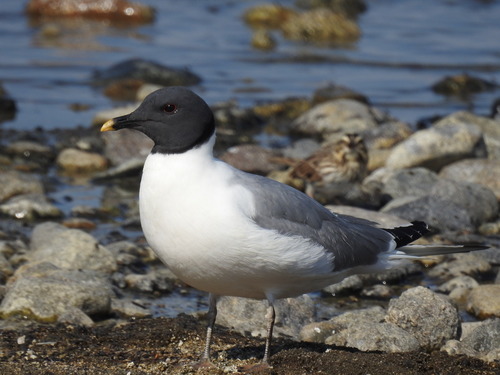
Sabine's Gull
The Sabine's Gull (*Xema sabini*) is a small, graceful gull known for its striking plumage and remarkable long-distance migrations. It is unique among gulls for its pelagic lifestyle, spending most of the year far out at sea, except during the brief Arctic breeding season. This species plays a crucial role in marine ecosystems as both predator and prey, and its extensive migrations link disparate parts of the world. It holds no particular cultural significance that's widely documented, but its beauty and unique life history make it a favorite among birdwatchers.
27-33 cm
Length
81-87 cm
Wingspan
Least Concern
Conservation Status
Distribution
Circumpolar, breeding in the high Arctic regions of North America, Europe, and Asia. Migrates south to winter in the Pacific and Atlantic Oceans, primarily off the western coasts of South America and Africa. Altitudinal range is generally limited to coastal areas and open ocean, rarely venturing far inland.
Lifespan
Typically up to 12 years in the wild.
Sabine's Gull's Habitat
Habitat Types
Coastal tundra, Open ocean, Upwelling zones
Climate Zones
Arctic, Subarctic, Temperate (during migration and winter), Tropical (during migration and winter)
Adaptations
Excellent long-distance flier, adapted to spending extended periods at sea. Their dense plumage provides insulation in cold environments. They are also adapted to feed on a wide range of marine prey.
Variations
No widely recognized subspecies, though minor variations in size and plumage may exist across its vast range.
Appearance
Breeding Plumage
Breeding adults have a distinctive dark gray hood, a white neck and underparts, and a striking wing pattern with black, white, and gray. Non-breeding adults lose the hood, developing a dusky head with white streaking.
Seasonal Feather Changes
Significant seasonal variation, with the most dramatic change being the development of the breeding hood.
Sex Based Plumage Differences
Minimal; males and females are very similar in appearance.
Notable Features
Forked tail, Black bill with a yellow tip, Distinctive triangular wing pattern
Diet and Feeding
Primary Foods
Small fish, Crustaceans, Marine invertebrates, Insects (during breeding season)
Foraging Behavior
Often feeds by dipping and picking prey from the water surface while in flight. May also plunge-dive or swim underwater to pursue prey. During breeding season, will forage on land for insects.
Specializations
Agile flight allows for efficient foraging over open water. Their bill shape is suited for capturing small, slippery prey.
Seasonal Diet Variations
Diet shifts from primarily marine prey during the non-breeding season to include more terrestrial insects during the breeding season.
Behavior
Social Structure
Gregarious outside of the breeding season, often forming large flocks. During breeding, they are typically colonial, nesting in loose aggregations.
Communication
Variety of calls, including high-pitched screeches and chattering sounds, Visual displays, such as head-bobbing and wing-lifting
Migration
Undertakes one of the longest migrations of any gull species. Travels thousands of kilometers between Arctic breeding grounds and Southern Hemisphere wintering areas. Migration is often along coastlines but can also occur over open ocean.
Territorial or Group Behaviors
Territorial during breeding, defending the immediate area around the nest. Otherwise, highly social and forms large flocks, especially during migration and on wintering grounds.
Conservation
Threats
Climate change (affecting breeding habitat and prey availability), Pollution (including oil spills and plastic ingestion), Disturbance at breeding colonies, Predation (by Arctic foxes, gulls, and jaegers)
Protection Programs
International treaties protecting migratory birds, Monitoring of breeding colonies
Local National Laws
Protected under various national and international laws, such as the Migratory Bird Treaty Act in the United States and Canada.
Population Trend
Stable
Population Estimates
Global population estimated to be around 330,000-370,000 individuals.
Interesting Facts
Sabine's Gulls are highly pelagic.
They spend most of their lives at sea, coming to land only to breed.
They undertake impressive migrations.
Some individuals travel from the Arctic to the Antarctic, covering vast distances.
Their forked tail is a distinguishing feature.
This feature, unusual among gulls, aids in maneuverability during flight.
Named after Sir Edward Sabine
An Irish astronomer, geophysicist, ornithologist, and explorer.
Faqs about Sabine's Gull
Where can I see a Sabine's Gull?
During the breeding season, they are found in the high Arctic. During migration and winter, they are best seen on pelagic birding trips off the coasts of North and South America, and Africa.
What is the biggest threat to Sabine's Gulls?
Climate change is a significant threat, as it can impact their breeding habitat in the Arctic and alter the distribution of their prey in the oceans.
How do they survive in such harsh environments?
They are well-adapted to cold temperatures, with dense plumage for insulation. Their ability to find food in open ocean environments is also crucial for their survival.
Copyright @ Nature Style Limited. All Rights Reserved.
 English
English